Heidelberg to Eltham
16km / Approx 4½ hours
Map
The path from Heidelberg to Eltham is very green (or at least, it is very green on a sometimes-sunny day at this time of the year after a few weeks of scattered rain – we’ve also walked here when it’s been very hot and yellow and brown, and when it’s been grey and pelting with rain!). In fact, one of the things that made this day of our walk out of the city so different from day one is that, barring the first and last couple of kilometres, the path barely encounters a street or vehicle track, let alone a freeway. At one point, about an hour into the walk, I turned a full circle and could see nothing but the trees, the sky, the river and G and D on the path ahead. I wondered if this would happen again at any point on this route. I also wondered whether, despite being within easy reach of the Hurstbridge train line, this is as out of the city as one can get while still being within the boundaries of Greater Melbourne?
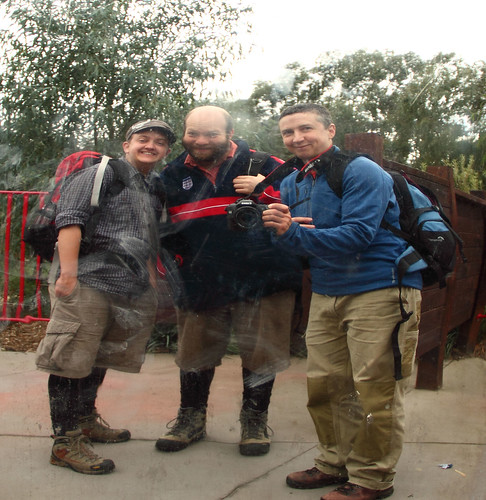
Meet your hosts: J, D & G
And anyway, I thought, what is it about walking out of the city that attracts me? Why walk out of the city? Perhaps this question implies two others. The first is “Why walk anywhere?” and in briefly answering this, I could say that I have the physical ability, the walking space/path, access to that space/path, the time in which to walk, the social freedom to walk there, and the desire to walk. Perhaps I will return to a fuller exploration of these elements in a later post. The second question is, “Why not walk into the city rather than out of it?” and my answer is twofold.
I have nothing against walking into or towards the city, and in fact I do so frequently: for meetings, for uni, to see films, to meet people for food or coffee. However, to me, walking into the city means having a definite destination, one confined to perhaps a mile radius from the intersection of Bourke and Swanston Streets. Once you are there, you are there: there is no further aim. In contrast, if you start at the intersection of Bourke and Swanston Streets and set a course in any direction, you will eventually find yourself either on the edge of, or walking beyond, the city. Once there (should you wish, and should you be equipped for such an adventure) you could keep walking south-ish around Port Phillip Bay, north to the Murray River, east through tail end of the Great Dividing Range or west to South Australia. There are as many possibilities as there are points on a compass. More, in fact! And this is an aspect of walking out of the city that really appeals to me – the multiplicity, the myriad choices one can make as a walker, the non-specific directions. They say all roads lead to Rome, but it must be equally true that they all lead out of Rome, and I like the mental image of a web of walked or walkable routes mapping spindly lines outwards from the city centre, meandering their ways to any number of potential destinations.
Walking – or just being – out of the city also has connotations of escape (this is personally interesting to me, because I feel, as a queer amongst other things, that I ‘escaped’ the suffocating country to live in the city almost a decade ago). I was thinking about the idea of ‘escaping the city’ the day before this walk, standing in my shop as trams rattled past, cars banked up at the intersections, a busload of school kids milled about on the footpath outside, and market vendors yelled at each other and potential customers. This cityscape has its own atmospheric appeal – one which can perhaps also be encompassed by a walk out of the city, because ‘out of’ seems to imply ‘beginning in’ – but at that moment I longed to be walking already, with my nose pointing (figuratively if not always literally) to the blue horizon, the promise of open spaces, the sound of birdsong and the smell of eucalyptus and fresh earth after rain . . . A fantasy, some might say, and they would be partly right: at the end of the walk to Eltham, I was only too happy to find an excellent cup of coffee to sip on the train back! But I also want to interrogate my own cynicism a little, because there are some things that are not a fantasy: the softness of grass or dirt instead of concrete or asphalt underfoot, and the different smell of those surfaces; the ability to wander, if only within a limited space, without having to stop and wait for cars or traffic signals; the visual lines of tree branches or waterways, surprisingly wild and unstructured despite their semi-urban setting; the sounds of the wind through grass or leaves or the wings of a bird in flight. These are things that give my city-acclimatised body space to experience something other than hard surfaces and architecturally sculpted walkways, other than the smells of car exhaust and restaurants, other than the ubiquitous visual snags of public writing, other than the constant chatter of the city traffic, and in turn this seems to encourage my mind to move in unexpected directions*.
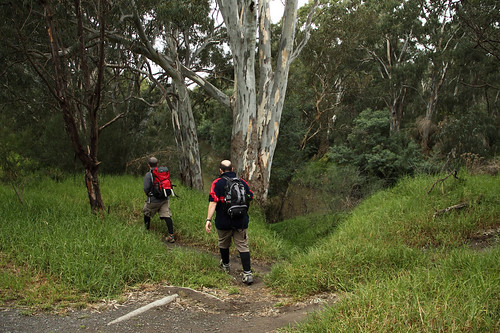
With the possible exception of the wonderful playground and picnic area in Templestowe, it is difficult to define this walk with reference to buildings, freeways or other human constructions. Instead, it might be better measured by our encounters with other living things: the enthusiastic puppies (including one of the least-timid whippets I’ve ever seen), the various duck species we observed (including the big white duck under the suspension bridge in Templestowe and the Australian Wood Ducks or Maned Ducks on Diamond Creek), the antics of two Rainbow Lorikeets beside the path, the straggling mass of highschool students we passed during 2km stretch after Rosanna Golf Club (perhaps walking to or from a PE event of some kind), the White Ibis backlit by the sun breaking through the clouds, and the beautifully marked Common Bronzewing pigeons that cast a wary eye at us then disappeared into the undergrowth (I think this is a different bronzewing to the one with which I’m familiar from childhood – perhaps that is the brush bronzewing?). The vegetation also slipped from urban deciduous trees (some still bright yellow or red), to reeds and wetland scrub, to bright green golf course, to a (disused?) grazing paddock, to the tall trees beside the river, to the recent revegetation on the slopes and banks, to the distinctively Australian urban-but-open space of Westerfolds Park, to the strangely neat plantings on Barak Bushland (near Wingrove Park), to the overrun market gardens along Diamond Creek. Then, of course, there was the constant presence of Yarra River and, after lunch, Diamond Creek. These are not living things, strictly speaking, but the waterways are what provide the environment for these birds, the lifeblood for these trees and the route for this walk.
(Incidentally, I forgot to bring my camera, but G brought his (much better one) along, so all these photos were taken by him!)
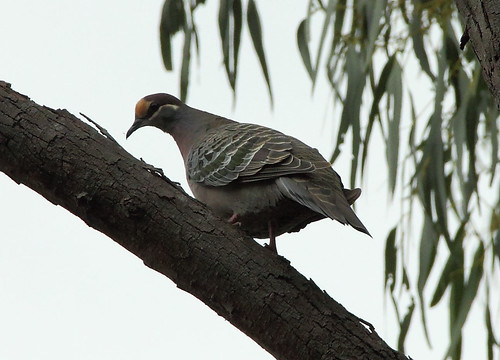
Bronzewing

Rainbow Lorikeet

Bronzewing
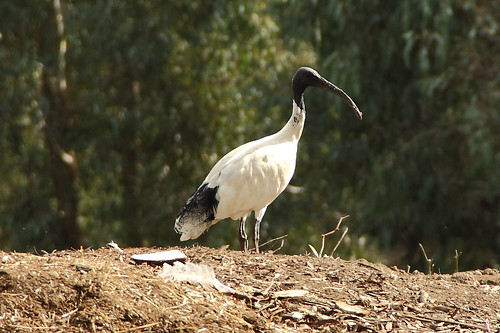
Australian White Ibis
The beginning of the walk heads from the train station down the main street of Heidelberg to the river flats, with a little detour up to the lookout point we visited at the end of the last walk, and then skirts between the playing fields and the Yarra for a couple of kilometres. We were once again without map (though we had one for the last leg up Diamond Creek), as we’d done most of this walk before, but round here and Yarra Valley Metropolitan Park it might have been handy to have one, as the path splits a number of times. You can take a route along a gravel road or follow the desire lines through the remains of a cattle yard, beside the river or closer to the ponds of the wetlands. This would be a great area to come if you wanted a shortish (< 1hr at a strolling pace) walk from Heidelberg station and a nice place to relax, explore and have a picnic.
The walk was shorter and easier than anticipated, and left us all feeling a little odd. We chose to have morning tea at the aforementioned playground, leaving the Main Yarra Trail and crossing the river on the suspension bridge. It hardly seemed like time to stop, because we hadn’t really hit our stride, but I knew this was about 5 or 6 kilometres into the walk, and breaking a day into thirds usually works well. We mucked about on the play equipment, and as a few drops of rain fell from the sky I realised that I’d accidentally left my raincoat at home on the couch when I’d repacked my bag that morning. Luckily the shower soon passed and we were not bothered by precipitation again!
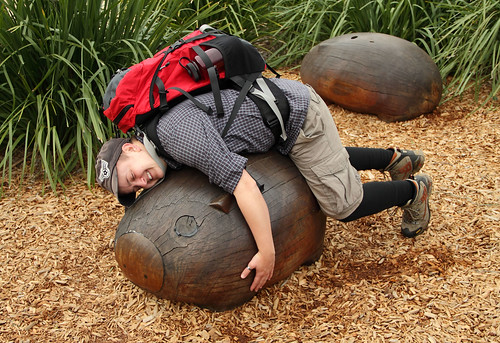
J and the wombat at the playground at morning tea
We took to the desire paths through Westerfold Park, wanting to be closer to the river, to quench our thirst for a bit of exploring, and to avoid the hard concrete of the official tracks. Although I really enjoy stepping off the pavement, I do want to acknowledge that too many people doing this too often can erode the soil – particularly along creek and river banks. The distance seemed to fly by, and all too soon we were walking through the Fitsimmons Lane underpass (don’t be fooled by the name, this ‘lane’ is a dual carriageway main road across the river). Once again, we chose the path beside the river – I had the sudden thought that apart from a brief moment near the start of day three, we wouldn’t be joining the Yarra again until we were half way through the last (two-day) section from Lilydale to Warburton – and crossed the footbridge into Eltham Lower.

Yarra near Diamond Creek
It was odd to think that we’d covered more than two-thirds of the walk already, as we’d only just got into the swing of it, and had barely worked up a sweat. Nevertheless, the lookout platform at the junction of the Yarra and Diamond Creek provides an excellent opportunity for a luncheon break, so break we did! We brought roasted pumpkin, topped this with soy sauce and sesame, then popped it into rolls with fresh lettuce and slices of Maasdam cheese – it worked surprisingly well. We lingered over our cups of tea, and G took some photos while D gave me a bit of a shoulder and neck rub, as I had a niggling headache. It was pleasant to have the area to ourselves with extra time to laze about. We watched the creek and river mingle, and I was once again reminded of the unexpected tranquillity that can be found when one steps off the roads and railway lines of Melbourne and takes the time to wander or simply sit beside the water.
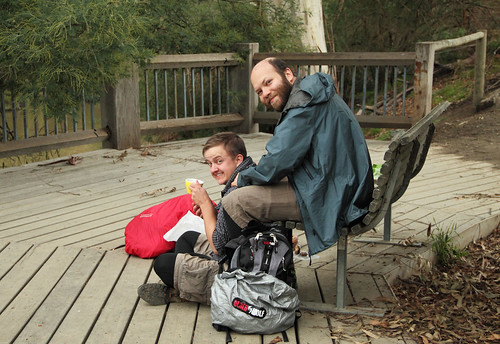
J&D after lunch
Eltham Lower Park buzzes on weekends: the miniature railway runs (it’s big enough to carry passengers sitting in single file), the ovals are in use and the pony club meets. However, just after lunch on a Friday it seems to be inhabited mainly by magpies, carolling and muttering and staring at passers-by with wary eyes. (I love magpies! They are so handsome!)
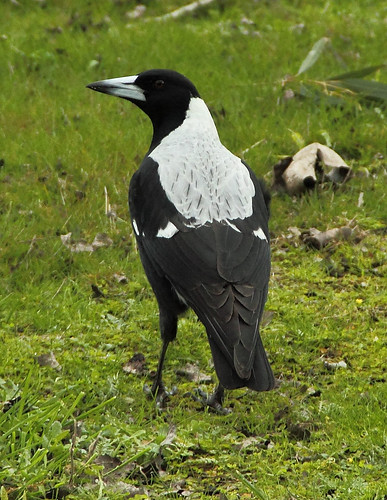

J at the miniature railway: Photo by D!
We crossed under Main Road and into Barak Bushland (probably one of the few parks in Melbourne named after specific Indigenous leaders of the area), then up along the streets and paths beside Diamond Creek. All too soon we were standing beneath the wooden trestle bridge that carries the train to Eltham station. This is one of my favourite rail bridges in Melbourne (the one at Jacana is also pretty good!), and Wikipedia tells me:
The timber trestle railway bridge across the Diamond Creek just south of the Eltham Railway Station is one of the few remaining examples of this type of construction in Melbourne. Built in 1901, the bridge was the subject of a lengthy dispute during the 1970s between the Victorian Railways and local residents over its preservation.
Some parts have been replaced with steel, but the majority of it is still timber. We walked past the impressive library, and then the Eltham CFA with its old bell (made by Lawsons?) out the front. At some point during the day we had crossed unknowingly from MFB to CFA territory – something I offered in my first post as a boundary marker for the edge of the city!
The headache that had hovered around my neck all day now felt like nails being driven into my skull when I stepped too hard. I think perhaps that we’d all caught a bit of the sun during the midday break in the clouds, and that we were a little dehydrated. However, my headache also had the hallmarks of caffeine withdrawal, so I headed to Sugar Kube, which I seemed to recall having good coffee the last time I stumbled across it. I was right! The coffee was still very good and the service very friendly, and I declared that – wooden trestle bridge and CFA to the contrary – we had definitely not yet left the city!
Footnote:
* I mentioned accessibility at the start of this post, and perhaps you might also like to read this post about the linked article.


